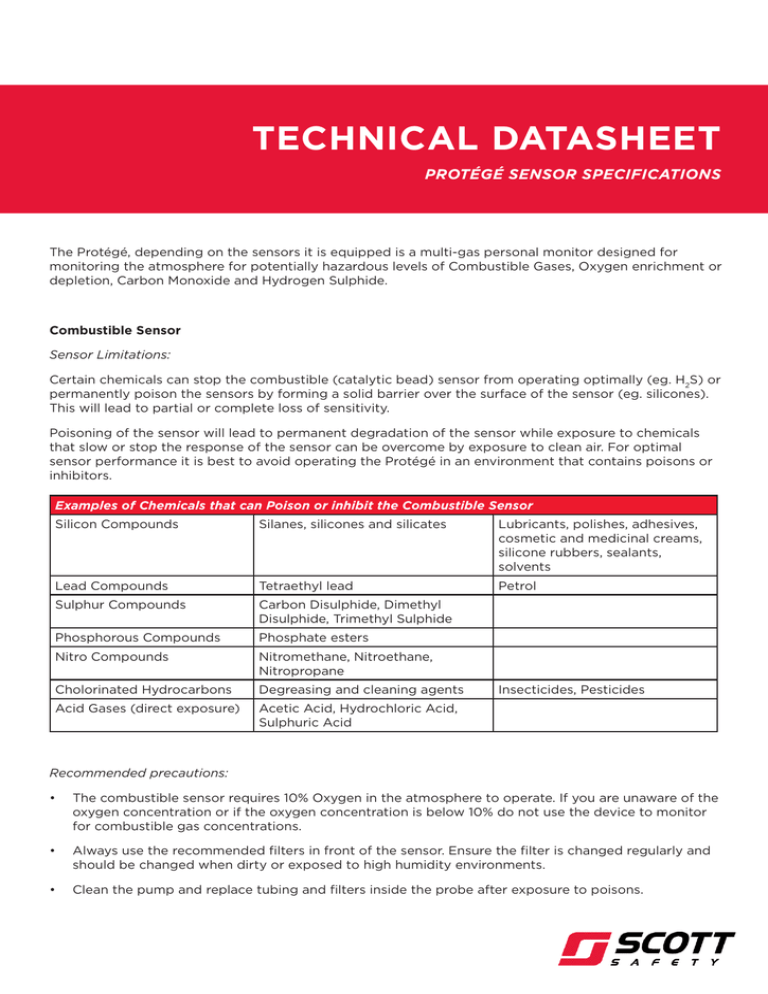
TECHNICAL DATASHEET
PROTÉGÉ SENSOR SPECIFICATIONS
The Protégé, depending on the sensors it is equipped is a multi-gas personal monitor designed for
monitoring the atmosphere for potentially hazardous levels of Combustible Gases, Oxygen enrichment or
depletion, Carbon Monoxide and Hydrogen Sulphide.
Combustible Sensor
Sensor Limitations:
Certain chemicals can stop the combustible (catalytic bead) sensor from operating optimally (eg. H2S) or
permanently poison the sensors by forming a solid barrier over the surface of the sensor (eg. silicones).
This will lead to partial or complete loss of sensitivity.
Poisoning of the sensor will lead to permanent degradation of the sensor while exposure to chemicals
that slow or stop the response of the sensor can be overcome by exposure to clean air. For optimal
sensor performance it is best to avoid operating the Protégé in an environment that contains poisons or
inhibitors.
Examples of Chemicals that can Poison or inhibit the Combustible Sensor
Silicon Compounds
Silanes, silicones and silicates
Lubricants, polishes, adhesives,
cosmetic and medicinal creams,
silicone rubbers, sealants,
solvents
Lead Compounds
Tetraethyl lead
Petrol
Sulphur Compounds
Carbon Disulphide, Dimethyl
Disulphide, Trimethyl Sulphide
Phosphorous Compounds
Phosphate esters
Nitro Compounds
Nitromethane, Nitroethane,
Nitropropane
Cholorinated Hydrocarbons
Degreasing and cleaning agents
Acid Gases (direct exposure)
Acetic Acid, Hydrochloric Acid,
Sulphuric Acid
Insecticides, Pesticides
Recommended precautions:
•
The combustible sensor requires 10% Oxygen in the atmosphere to operate. If you are unaware of the
oxygen concentration or if the oxygen concentration is below 10% do not use the device to monitor
for combustible gas concentrations.
•
Always use the recommended filters in front of the sensor. Ensure the filter is changed regularly and
should be changed when dirty or exposed to high humidity environments.
•
Clean the pump and replace tubing and filters inside the probe after exposure to poisons.
PROTÉGÉ SENSOR SPECIFICATIONS
•
Reduce the exposure time of the sensor in poison environments and turn off the monitor when not in
use.
•
Decrease the flow rate of gases over the sensor during operation in poison environments, or use in
diffusion mode.
COMBUSTIBLE SENSOR SPECIFICATIONS
Range
0 to 80% LEL; 0 to 5.0% VV Gas
Response Time
T50=10 seconds; T90=30 seconds
Operating Temperature
-40 to +200°C
Humidity
0 to 90% RH, Non-Condensing
Storage Temperature
0 to 20°C
Poison Resistance
Resistant to H2S poisoning
H2S filter Lifetime
Typically 1,000ppm hr
Expected Life
2 years in air
Warranty
2 years
Oxygen Sensor
OXYGEN SENSOR SPECIFICATIONS
Range
0.0 to 25.0%
Response Time
T95=15 seconds
Operating Temperature
-20 to +50°C
Humidity
5 to 90% RH, Non-Condensing
Storage Temperature
0 to 20°C
Expected Life
2 years in air
Warranty
2 years
Pressure Effects:
The normal operating range for oxygen sensors is within 20% of ambient pressure. Pressure changes are
common when entering a tunnel, going underground or entering high-rise buildings. Ambient pressure
does not affect the sensor.
During sudden pressure changes the sensor needs time to stabilise. It is likely that the alarm will be
activated if the monitor is on. In such instances the Protégé should be allowed to equilibrate under the
new pressure BEFORE switching the monitor on. After stabilising the sensor will perform as normal.
Temperature Effects:
Oxygen sensors show almost no effect from gradual temperature changes. Sudden temerature changes
may cause the oxygen senosr to alarm but readings will equilibrate very quickly.
In the case of sensor drift caused from pressure or temperature changes perform a zero calibration.
PROTÉGÉ SENSOR SPECIFICATIONS
Carbon Monoxide Sensor
CARBON MONOXIDE SENSOR SPECIFICATIONS
Range
0 to 999pm
Resolution
1ppm
Response Time
T90 <25 seconds
Operating Temperature
-20 to +50°C
Humidity
15 to 90% RH, Non-Condensing
Storage Temperature
0 to 20°C
Expected Life
2 years in air
Warranty
2 years
The Carbon Monoxide sensor may exhibit a response to certain gases in the environment other than the
target gas. The sensor has been tested with a number of common gases and the results are shown in the
table. The table shows the typical response expected from a Carbon Monoxide sensor when exposed to a
given test gas.
CONCENTRATION AT TWA LEVELS
Sensor Cross Sensitivity
Filtered against H2S, 15ppm
<0.5ppm
Filtered against SO2, 5ppm
~0ppm
Nitric Oxide, 35ppm
<3ppm
Nitrogen Dioxide, 5ppm
-1ppm
Chlorine, 1ppm
~0ppm
Hydrogen, 100ppm
<40ppm
Ethylene, 100ppm
<50ppm
Ethanol, 200ppm
~0ppm
Hydrogen Sulphide Sensor
HYDROGEN SULPHIDE SENSOR SPECIFICATIONS
Range
0 to 500pm
Resolution
0.1ppm
Response Time
T90 <30 seconds
Operating Temperature
-20 to +50°C
Humidity
15 to 90% RH, Non-Condensing
Storage Temperature
0 to 20°C
Expected Life
2 years in air
Warranty
2 years
PROTÉGÉ SENSOR SPECIFICATIONS
The Hydrogen Sulphide sensor may exhibit a response to certain gases in the environment other than the
target gas. The sensor has been tested with a number of common gases and the results are shown in the
table. The table shows the typical response expected from a Hydrogen Sulphide sensor when exposed to
a given test gas.
CONCENTRATION AT TWA LEVELS
Sensor Cross Sensitivity
Carbon Monoxide at 300ppm
<2ppm
Sulfur Dioxide, 5ppm
~-1ppm
Nitric Oxide, 25ppm
<1ppm
Hydrogen, 10,00ppm
<10ppm
Nitrogen Dioxide, 5ppm
Australia: Scott Safety*
PO Box 876, Guildford, NSW 2161, Australia
Phone: 131 772 Fax: 1800 651 772
Email: scott.sales.anz@tycoint.com
* Scott Safety is a division of Rindin Enterprises Pty Limited ACN 089 330 914
New Zealand: Scott Safety
Private Bag 93011, New Lynn, Auckland, New Zealand
Phone: (64 9) 826 1716 Fax: (64 9) 826 2288
Email: scott.sales.anz@tycoint.com
~ppm
www.ScottSafety.com
© Scott Safety. All Rights Reserved

